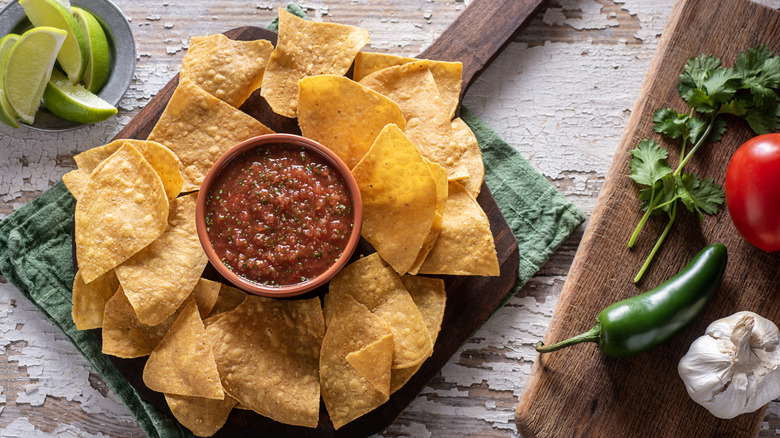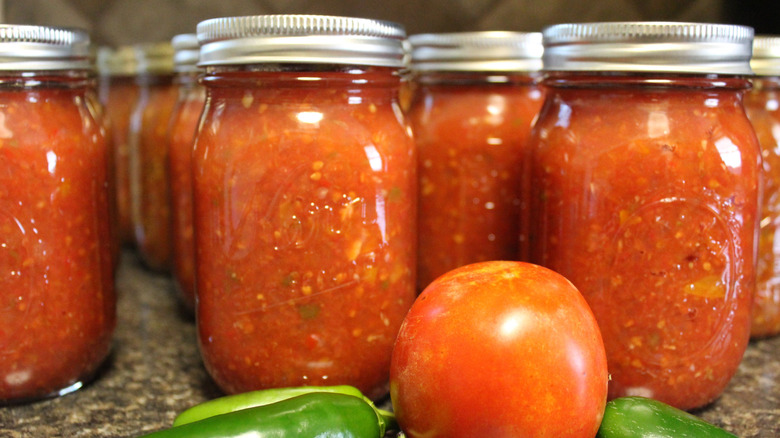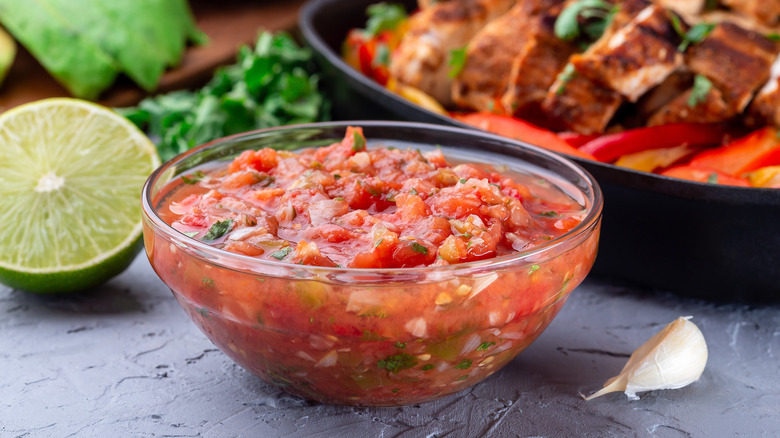How Long Store-Bought Salsa Lasts Once It's Been Opened
When a late-night snack craving hits, it may be tempting to reach for that long-forgotten jar of salsa in the back of your fridge and crisp up some stale tortilla chips in the microwave. But while the chips might be okay to eat, salsa can make you sick if it's been too long since you first opened it. Many households tend to keep this condiment around for a long time, with some even believing it doesn't spoil, but this simply isn't true.
Store-bought salsa stays at its best for about two weeks after opening. If you use up all the sauce within this timeframe, it should taste pretty similar from start to finish. Beyond this period, salsa may not taste quite as fresh, but it will remain safe to consume for up to four weeks total, so long as it's been properly stored in an airtight container in the fridge. The longer the salsa stays open, however, the more likely it is to go bad.
No matter how strongly you want to enjoy a few scoops of salsa, even if you can't remember when you opened it (or even bought it), it's best to play it safe and toss it out if you're unsure of its quality. And even if you know you opened that jar just last week, always look for signs of spoilage before you enjoy your salsa.
How to tell if salsa is bad
When judging whether your salsa is still good or not, there are a few telltale signs to keep an eye out for. The first and most obvious is mold growth. If you find fuzzy, discolored spots in your salsa or even a thin coating inside the jar, it should be thrown out immediately. This might sting if you just bought the salsa, but unlike with some other foods, you can't scoop mold out of this condiment and eat the rest. Eating molk spores can cause a variety of unpleasant side effects, beyond an upset stomach.
The smell of the salsa should also be taken into account. Safe-to-eat salsa should smell fresh and slightly spicy, if you like your condiments hot. If it smells rancid or sour, it's a sign that the ingredients have spoiled. A slightly more subtle indicator is the color of the salsa. If the chunks of veggies inside have dulled, changed color, or turned darker, the sauce probably isn't good to eat.
If your salsa shows none of these red flags, but tastes "off" when you take a bite, don't continue eating it. Besides the fact that it won't taste very good, consuming bad salsa could put you at risk for foodborne illnesses. If you know you can't eat a big tub of salsa in time, freezing it can be a great way to preserve it.
Freeze salsa to enjoy later
Before freezing salsa, it has to be fresh to begin with — the process won't save salsa past its prime. Don't just stick the glass jar into the freezer, either. As the salsa freezes, the liquid inside will expand, which puts pressure on the glass and can cause it to crack or even explode. Instead, you should transfer the salsa into a freezer-safe resealable plastic bag, or pour it into an airtight plastic container.
Helpfully, you can opt to freeze the salsa in smaller portions. This way, if you only eat salsa occasionally, you can only take out as much as you need from the freezer, without having to chip off a huge frozen block of the stuff. When you're ready to eat a portion of your salsa, transfer the frozen sauce to the fridge and allow it to defrost overnight. Salsa will stay safe in the freezer for around four months.
If you find that the flavor of the thawed condiment is a little dull, you can mix in some fresh ingredients, like diced jalapeños, cilantro, or lime juice. Even nut butter can elevate the taste of store-bought salsa. While your dip may not taste as fresh after it's thawed, there are so many ways to jazz it up, and it can be a great way to preserve the quality of the sauce for a long time to come.



